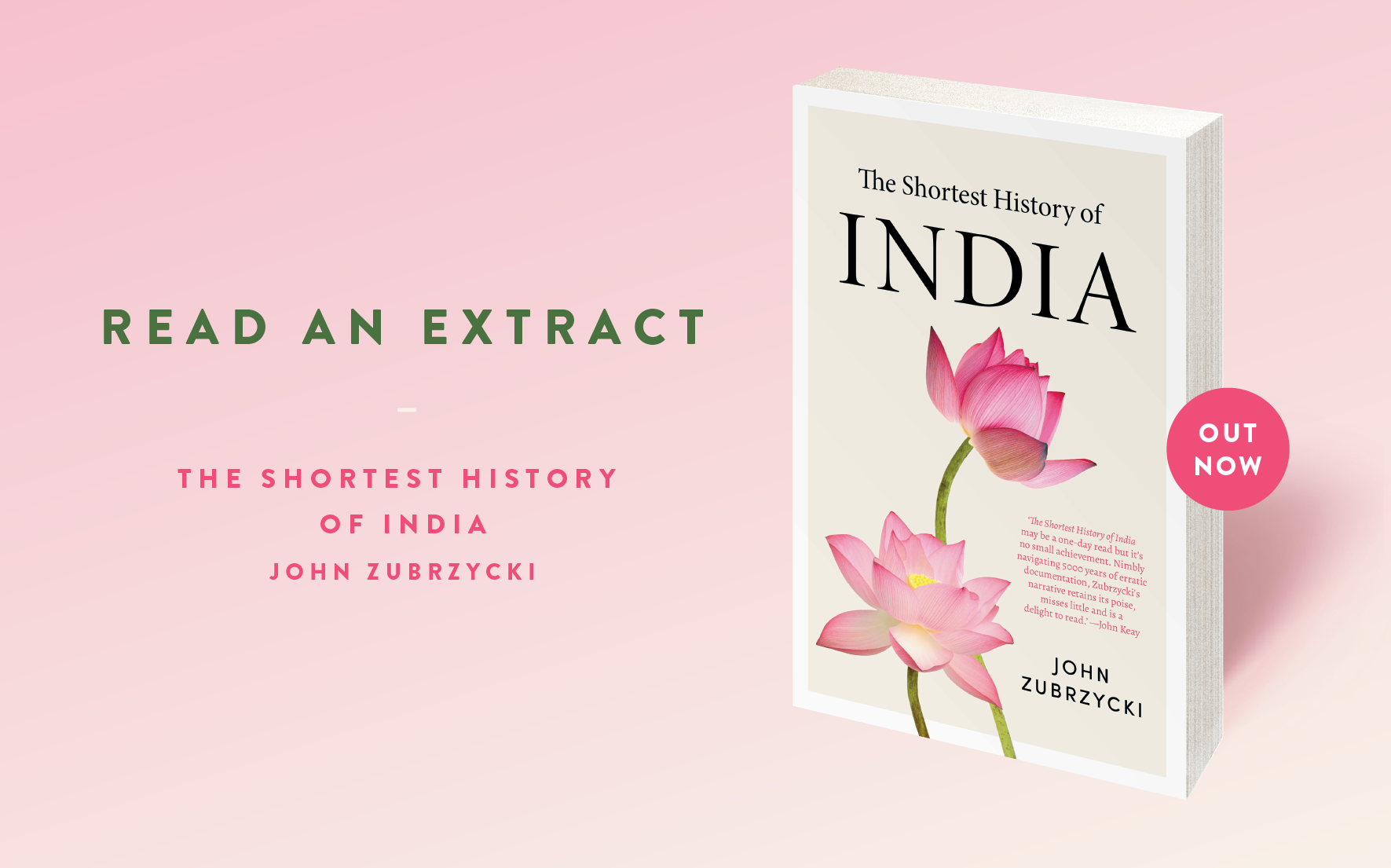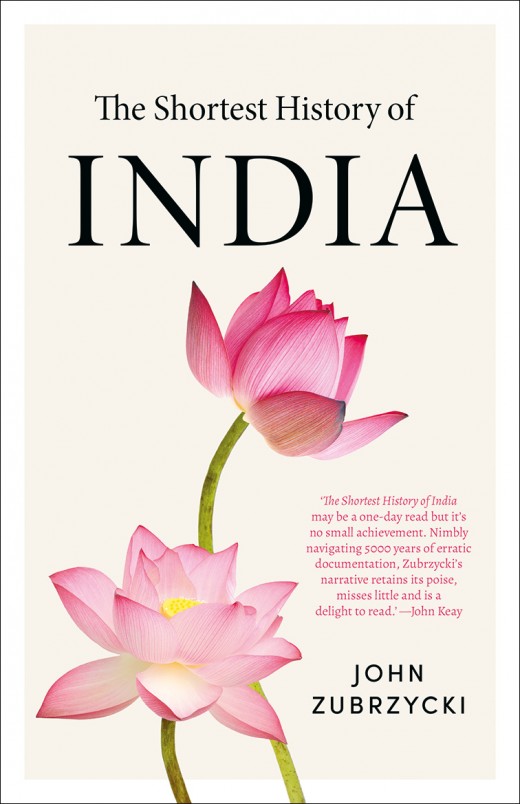News

News >
Summer of Reading: The Shortest History of India
Part of our Summer of Reading series: An illuminating and concise telling of the 5000 years of turbulent history that led India from the ruins of ancient civilisations to emerging global superpower
‘Whatever you can rightly say about India, the opposite is also true.’
—British economist Joan Robinson
EARLY ON THE MORNING OF 9 AUGUST 1942, leader of the Indian National Congress Jawaharlal Nehru and nine of his colleagues were bundled into a train at Bombay’s Victoria Terminus. Their destination was Ahmadnagar Fort in the sweltering hills of modern-day Maharashtra. In 1707, the last of the Great Mughals, Aurangzeb, had died in the fort – the moment of his passing coinciding with a whirlwind ‘so fierce that it blew down all the tents standing in the encampment … villages were destroyed and trees overthrown’. Under the British, Ahmadnagar had been turned into a high-security jail. Nehru’s incarceration would last two years and nine months – the longest of his nine stints as a prisoner of the Raj. His crime was to launch the ‘Quit India’ movement, a desperate bid by Congress to pressure Britain into granting immediate independence if it were to count on India’s full support for the war effort. The war would be almost over by the time he was released.
India’s future prime minister described Ahmadnagar as a kind of ‘Plato’s cave’ – a prison whose inmates can only see shadows of what is going on around them. Yet he took solace in the sky over his prison yard with its ‘fleecy and colourful clouds in the daytime, and … brilliant star-lit nights’. Inside the fort’s walls was a firmament of a different kind – Nehru’s small cohort of fellow prisoners represented a cross-section of Indian politics, scholarship and society. Between them, they spoke four of India’s classical languages – Sanskrit, Pali, Arabic and Persian – as well as more than half a dozen of its modern ones, including Hindi, Urdu, Bengali, Gujarati, Marathi and Telugu. ‘I had all this wealth to draw upon and the only limitation was my own capacity to profit by it,’ Nehru mused. There was plenty of time to cultivate a garden, hold impromptu seminars and speculate on what was going on in the rest of the country. As he had done during his earlier jail terms, Nehru took the opportunity to satisfy his voracious appetite for reading classic works on history and politics, and to translate those ideas into his own writings.
Compiled during many long, hot days, The Discovery of India (1946) would become his best-known work. Nehru dismissed it as a ‘jumble of ideas’– a journey through the past that also ‘peeped into the future’. Much of the work is just that – a skein of unconnected thoughts. But he begins the book with a fundamental question: ‘What is this India, apart from her physical and geographical aspects?’ In the last chapter, he feels confident enough to offer an answer, writing that India is ‘a cultural unity amidst diversity, a bundle of contradictions held together by strong but invisible threads … She is a myth and an idea, a dream and a vision, and yet very real and present and pervasive.’
Nehru’s conclusion might appear frustratingly vague and contradictory to aspiring students of India’s history. Yet India as both an idea and an entity has endured for thousands of years, accommodating a diversity of religions, cultures, languages, ethnicities and castes. ‘India has had that past tradition of synthesis,’ Nehru pointed out in a speech in 1953, adding: ‘Currents came to it, rivers of humanity flowed into it, and got mixed up with the ocean of India, making changes there no doubt, and affecting it and being affected by it.’
Nehru took for granted the importance of ‘discovering India’. But for many outsiders, making the ‘passage to India’, to borrow the title from E.M. Forster’s book, is challenging. The country’s cultural and linguistic complexity, its extremes of wealth and poverty, its mosaic of religions and rituals, and its convoluted and increasingly contested history might deter all but the most committed. It may seem impossible to meld overlapping cultural, political and social currents into a coherent and comprehensive narrative. As the Bengali author and scholar Nirad Chaudhuri (1897–1999) wrote back in the 1950s, India is ‘so vast and so populous, the individuals who form the exceptions may well run into millions’.
Whatever the hurdles India’s complexity puts in the path of students and historians, it would be a folly to ignore the wider lessons of the country’s past and present. India is the world’s oldest civilisation and its largest democracy. It is the fulcrum between the eastern and western parts of Asia and an assertive Indian Ocean power. It is also changing rapidly, ditching the last remnants of the socialist experiment that guided its economy for decades and adapting to a new world order where its rhetoric of non-alignment – its refusal to side with one superpower or another – has less and less relevance.
India has yet to replicate China’s shiny bullet trains, its glittering megalopolises or its giant factories producing laptops and smartphones for tech-hungry consumers around the world. It has also been poorly served by its democratically elected leaders, who have consistently failed to harness the country’s full potential. Rich in natural resources and with an immense pool of highly educated, globally literate workers, India holds huge promise. By 2025, one-fifth of the world’s working-age population will be Indian, and a billion Indians will be connected to one another and the world through smartphones. India’s population is expected to overtake China’s in 2027, as both countries nudge the 1.5 billion mark. By then, India’s five largest cities will have economies of comparable size to middle-income countries such as Serbia and Bulgaria today. Before the Covid-19 pandemic, India was on track to become the world’s third-largest economy as early as 2031, after China and the United States, measured by market exchange rates.
Unlike China’s history, which can be divided neatly into dynastic periods such as those of the Yuan, the Ming or the Qing, India’s past is untidy, with disparate and competing centres of power. Even at the height of its imperial expansion, India’s three great empires – Mauryan, Gupta and Mughal – did not control the entire subcontinent. It was not until the defeat of the Marathas in 1818 that Britain could make that claim. Even then, the princely states, which covered two-fifths of India’s landmass and were home to one-third of India’s population, retained some nominal independence.
To include here the reign of every ruler on the subcontinent, the fortunes of all its major and minor dynasties, and the outcome of every battle for territory and wealth – not to mention India’s contribution to the world in fields such as science, literature and art – would be self-defeating, a jumbled mass of names, dates and declarations devoid of texture and depth. It has been challenging to condense 5000 years of Indian history into a couple of hundred pages while trying to convey these subtleties, but it is necessary.
WHAT’S IN A NAME?
For traders and invaders who made the long trek over the Hindu Kush and arrived on the plains of what is now Pakistan’s Punjab province, the first significant geographical barrier was the Sindhu River. Unable to pronounce the S, the Persians called the river the Hindu. When the Greeks arrived in the fourth century BCE, the H was dropped and it became the Indus, as it is known today, and the lands beyond it, Ἰνδία, the root of the word India. In the same way that America and Australia are inventions that bear no relation to how the pre-colonial inhabitants referred to their lands, the name India never really took hold until the European trader-encounter of the sixteenth and seventeenth centuries brought to India’s shores Portugal’s Estado da Índia, the Dutch Vereenigde Oost Indische Compagnie, France’s Compagnie des Indes and, finally, Britain’s East India Company. A more common name was Hindustan, which referred to ‘land of the Indus’ rather than ‘land of the Hindus’. The generic term ‘Hindustanee’ was commonly used to refer to anyone who came from what was then British India until the early twentieth century.
The Sanskrit name for India is Bharata, which was defined in the third-century text the Viṣṇupurāṇa: ‘The country that lies north of the ocean, and south of the snowy mountains, is called Bhārata, for there dwelt the descendants of [King] Bhārata. It is nine thousand leagues in extent, and is the land of works, in consequence of which men go to heaven, or obtain emancipation.’ The opening article of the Indian Constitution states: ‘India, that is Bharat, shall be a Union of States.’
Geographically, it is relatively simple to define the parameters of India and Indian civilisation over the millennia. Approximately 180 million years ago, the supercontinent of Gondwana began to break up, with the Indian Plate drifting in a northeast direction at the rate of around 15 centimetres a year until it collided with the Eurasian Plate nearly 55 million years ago to create the world’s highest mountain range, the Himalayas. The 2500-kilometre-long range marks the northern boundary of what is referred to today as the Indian subcontinent. Quadrilateral in shape, its eastern extremities are hemmed by the jungle-clad ranges that form the Indo–Myanmar border. In the west lies the Hindu Kush, where the Bolan and Khyber passes became the pathways for waves of invading armies. The subcontinent’s southern boundary is a massive peninsula that protrudes like a spearhead into the Indian Ocean.

Today, the subcontinent is divided into five nations. India is the largest of these, with an area of just under 3.3 million square kilometres, if all of contested Kashmir is included; it measures almost 3200 kilometres from north to south and 2900 kilometres from east to west. It is also the most populous, home to approximately 1.4 billion people. It shares land borders with the other four countries of the subcontinent – Pakistan, Nepal, Bhutan and Bangladesh – as well as with China and Myanmar. India is also one of the most densely populated countries in the world, with around 400 people per square kilometre – twice that of China.
As with Egypt and Mesopotamia, which flourished on the Nile, Tigris and Euphrates rivers, India’s earliest civilisations grew up around the fertile floodplains of the Ganges and Indus. From its source at Gangotri, in the northeast, the Ganges cuts through the Himalayas, before it flows eastwards and merges with the Brahmaputra River to form one of the agriculturally richest deltas in the world, encompassing the modern Indian state of West Bengal and the independent nation of Bangladesh. South of the Vindhya mountain range, which divides the subcontinent neatly in half, is the Deccan plateau, bounded on either side by the Eastern and Western Ghats. The major rivers of the Deccan and southern India include the Narmada, the Godavari, the Krishna and the Kaveri.
One of the most anticipated announcements in India is the annual monsoon forecast. The southwest monsoon, which begins in June and lasts until September, dumps approximately 80 per cent of the country’s annual rainfall. Parts of northeastern India receive up to 14,000 millimetres a year, while the western Thar Desert of Rajasthan can get as little as 100 millimetres. The monsoon is crucial to agricultural output in a country where only half of the farmland is irrigated. By raising food prices and cutting rural incomes, a poor monsoon can topple a government.
The subcontinent’s rivers, mountains and coastline define its sacred geography. Varanasi, also known as Kashi or the City of Light, is located on the Ganges. Sacred to the god Śiva, the city is as holy to Hindus as Mecca is to Muslims, the Vatican is to Roman Catholics and Jerusalem is to Jews. For Hindus it is a place of spiritual liberation. To die here is to achieve moksha, or freedom from the endless cycle of rebirth. Upstream at the confluence of the Ganges, Yamuna and mythical Saraswatī rivers is Prayagraj, formerly known as Allahabad, the site of the greatest gathering of humanity anywhere in the world – the Kumbh Mela – which occurs on four occasions every twelve years. Devout pilgrims carry jars of sacred Ganges water to the dozens of holy places scattered around mountain ranges, rivers and coastlines. When Sufi mystics, practising a more devotional form of Islam, began arriving in India early in the last millennium, they too established networks of dargahs or shrines, such as that of Nizamuddin Auliya in Delhi and Mu’inuddin Chishti in Ajmer, one of the holiest places of Islam aside from Mecca and Medina. The web of pilgrimage routes crisscrossing India includes places sacred to Sikhs, Jains, Buddhists and Christians.
Though formidable, the subcontinent’s geographical boundaries have always been porous, allowing new cultures, agricultural practices, languages, religions and even methods of warfare to take root. The nomadic Āryans, who spread into northern India from the steppes of Central Asia, were followed by the armies of Alexander the Great. From western China came the Kuśāṇas and from the Central Asian steppes the Hūṇas, a tribe related to the Huns. Chinese pilgrims seeking scholarship and enlightenment made their way to centres of learning such as Nalanda, considered the first university in the world, where the subjects taught ranged from Buddhist theology to alchemy and astronomy. The rise of Islam in the seventh century made its presence felt through trade and then conquest, culminating with the establishment of the Delhi Sultanate and the Mughal Empire. Even at the height of Mughal supremacy in the seventeenth century, European powers including the Portuguese, Dutch, French and British had footholds in India.
Over the millennia, the influence of Indian religion, thought and science would spread well beyond its borders, giving the world everything from the decimal system to yoga, from Bollywood movies to vegetarianism. The legacy of British colonial rule inculcated the English language with a masala of Indian words: bungalow, polo, gymkhana, loot, mogul, jungle and thug, to name just a few. Indian soft power predates the Raj by two millennia. In c. 240 BCE, the Third Buddhist Council – held in Pāṭaliputra, in the country’s north – was instructed by the Emperor Aśoka (r. c. 268–c. 232 BCE) to send emissaries to nine countries to spread Buddha’s teachings. As early as the first century CE, Hinduism was making its presence felt as far away as the islands of Java and Bali in the Indonesian archipelago. By the 1960s and 1970s, gurus such as Maharishi Mahesh Yogi had become household names in the West for preaching the benefits of transcendental meditation to The Beatles, and thousands of Westerners were making their way along the hippie trail.
India’s other outstanding gift to the world has been its diaspora. Numbering around 18 million, it is the largest in the world. Zubin Mehta is a name synonymous with conductors of Western classical music. M. Night Shyamalan’s films inducted the genre of ‘scary movies with a twist’. CEOs of Indian heritage head major companies including Google, Twitter and Microsoft. The diaspora’s reach was symbolised in January 2021 by the swearing in of Kamala Harris as the first American vice president of South Asian heritage. As the ceremony was beamed in live to their smartphones, residents of her ancestral village of Thulasendrapuram, about 350 kilometres from Chennai, lit firecrackers, distributed sweets and flowers as a religious offering and prayed at the local temple for her welfare.
Nehru once compared India’s ability to absorb and conserve ideas from abroad to a palimpsest: an ancient manuscript that is written over again and again without completely obliterating the layer before. The following pages of this short history aim to bring those layers to life.
Share this post
About the author
John Zubrzycki is an Australian author with a PhD in Indian history from the University of New South Wales. A former foreign news editor with The Australian, he has worked as a correspondent in India and as a diplomat in New Delhi and Jakarta. He is the author of four books on India, the latest being House of Jaipur: The Inside Story of India’s Most Glamorous Royal Family.
More about John Zubrzycki




